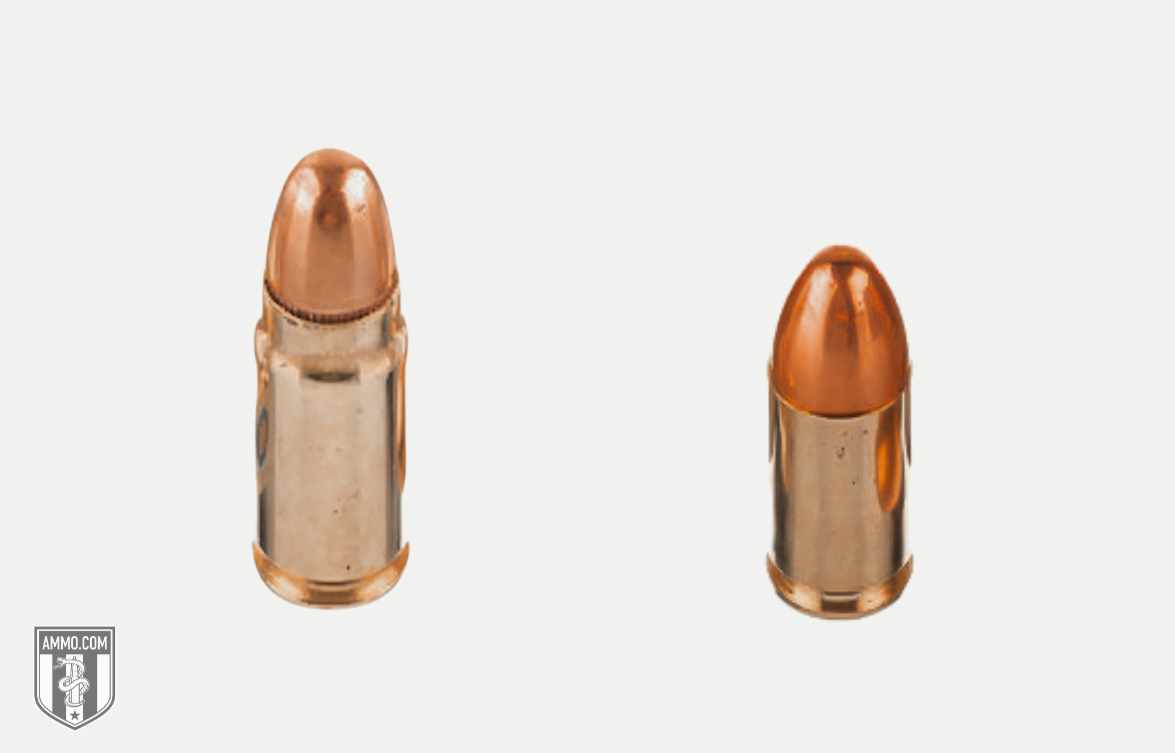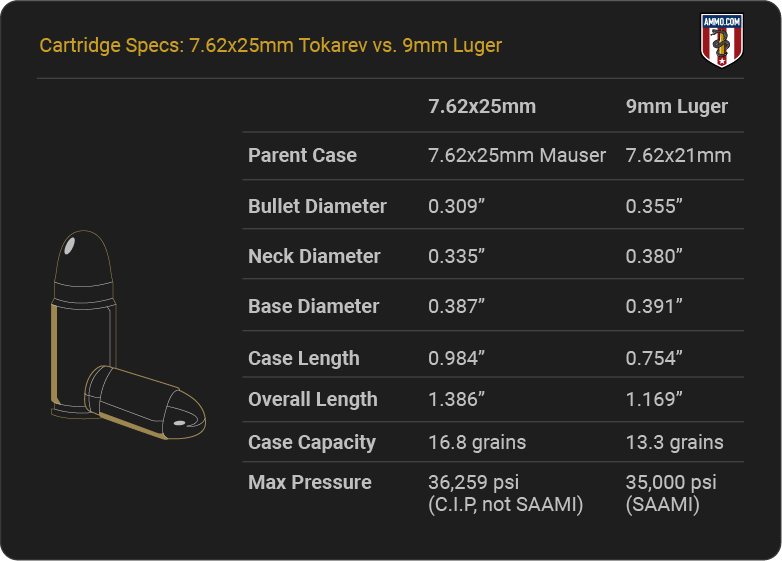7.62x25 vs. 9mm: Soviet vs. Austrian Design
 The 7.62x25mm Tokarev is a Soviet rimless bottleneck submachine gun and pistol cartridge that entered production in 1930. The Russian military eventually replaced it with the 9x18mm Makarov – but that’s not the 9mm we’re comparing the 7.62x25mm to in this article.
The 7.62x25mm Tokarev is a Soviet rimless bottleneck submachine gun and pistol cartridge that entered production in 1930. The Russian military eventually replaced it with the 9x18mm Makarov – but that’s not the 9mm we’re comparing the 7.62x25mm to in this article.
We are talking about the ever-popular 9mm Luger: designed by Georg Luger, an Austrian gunsmith, in 1901. It’s a rimless tapered handgun and submachine gun cartridge that is used by civilians, law enforcement and military organizations worldwide.
Let’s see how the cartridges compare to one another!

Comparing The 7.62x25 to 9mm
Despite having been designed decades apart, these cartridges do share some similarities. We’ll focus on their differences so you can decide which is better for your situation by the end of this article.
We’ll compare and contrast their recoil, accuracy, stopping power, self-defense capabilities, cost and availability, and reloadability. At the end, we’ll tally up the scores and declare a winner for all of time! Okay, it’s admittedly not that dramatic, but you will better understand which round will work better for you.
Technical Specs
You can tell these two rounds apart at a glance. The first noticeable differences are their overall lengths and one is bottlenecked. The 7.62x25 Tokarev is a bottlenecked cartridge with an overall length of 1.386 in, while the 9mm Luger has a shorter length of 1.169 in. The 7.62x25’s extra length comes from its case: 0.984 in, as opposed to 0.754 for the 9mm Luger. Its longer case and same rim diameter naturally means the 7.62x25mm Tokarev cartridge has more case capacity: 16.8 grains H2O versus 13.3 grains H2O for the 9mm Parabellum.
The 9mm Luger fires a larger bullet in diameter and weight. 9mm bullet diameter is 0.355 in and fires a bullet ranging in weight from 90 to 165 grain. The 7.62x25mm bullet diameter is 0.309 in and fires a bullet ranging in weight from 85 to 90 grain.
Now that we know some of the cartridges' physical differences, let’s discuss how they affect performance in everyday situations.

How Does the Recoil of 7.62x25 Tokarev Compare to That of 9mm Luger Rounds?
It is crucial to take recoil into consideration. A round with heavy recoil will be more challenging to control, and will slow the rate of your follow-up shots. The potential for flinching (which makes you less accurate) is also an issue for heavy-recoil cartridges.
Felt recoil differs from shooter to shooter, and often depends on the firearm, stance, and ammo choice. Free recoil is an objective measure of how much a cartridge kicks based on firearm weight, muzzle velocity, propellant weight, and bullet weight.
Both cartridges are known for having low recoil. The 7.62x25mm Tokarev has about 4.6 ft-lbs of free recoil when you’re firing an 85 grain FMJ at 1,525 fps from a 1.9 lbs pistol. The 9mm Luger has about 4.4 ft-lbs when you’re firing a 115 grain JHP at 1,190 fps from a 2 lbs Glock pistol.
The difference in recoil is so minimal that you won’t be able to sense it when firing the two rounds. Generally, any difference within 1 ft-lbs is incredibly difficult to perceive.
This section is a tie because the difference in recoil is nearly impossible to distinguish.
Accuracy: 9mm vs. 7.62x25

A cartridge's accuracy depends on many factors, including the firearm, bullet design, shooter, and environmental factors. Recoil and trajectory also play pivotal roles.
Since these cartridges were designed for pistols and submachine guns, we can expect their trajectories to be similar within 25 yards (the distance the average self-defense situation occurs). However, the 7.62x25mm has a much flatter trajectory as we increase the distance to the target.
When sighted in at 25 yards, the 7.26x25mm 85 grain bullet drops only -5.8 in at 100 yards. The 9mm 115 grain bullet drops -9.7 in under the same conditions.
Accuracy will appear identical at close range. As the target moves farther away, the 7.62x25mm Tokarev’s flatter trajectory will significantly facilitate accurate shot placement..
The 7.62x25 wins this section.
Stopping Power: 7.62x25 vs. 9mm Parabellum
The stopping power debate can take many forms. When discussing stopping power, many shooters often mean depth of penetration, as reaching vital organs is critical in quickly stopping a threat. Another direction is to emphasize the width of the hole created by the projectile. The bigger the hole, the quicker the threat is stopped. Shooters must consider both factors; emphasizing one over the other is like arguing whether length or width is more important to calculate the area of a rectangle.
The part that many shooters conveniently neglect to mention is shot placement. A bullet that stamps a big hole through a threat’s hand won’t quickly neutralize said threat. However, a small, well-placed bullet can quickly stop a threat without penetrating as deeply as the larger bullet.
The 7.26x25mm is known for its penetrating power. It can penetrate steel helmets and low-level Kevlar body armor. On the other hand, the 9mm creates a larger hole – and has many projectiles designed with stopping power specifically in mind.
Striking energy is another crucial factor regarding stopping power. The striking energy depends on the bullet's weight, velocity, and load. The 9 mm will have an average of about 413 ft-lbs of striking energy, whereas the 7.62x25mm will average about 553.2 ft-lbs.
Considering all of the above, this section is a tie. The 7.62x25mm penetrates much deeper than the 9mm Luger, but the 9mm offers more bullets designed for stopping a threat and causes more damage to vital organs.
Ammo & Firearm Cost/Availability
I’ll keep this section relatively short and sweet because the 9mm has many more firearms and ammo options at lower prices than the 7.62x25mm in the U.S.
The 9mm is much more popular among competitive shooters, concealed carriers, law enforcement, and weekend target shooters. Since the 9x18mm Makarov replaced the 7.62x25mm in Russian service, it has also lost traction in countries including China, Pakistan, and Russia.
9mm ammo is often less than half the price of 7.26x25mm ammo. While you can find some cheaper 7.62x25mm pistols for sale, they’re still far less abundant than 9mm pistols. They’re also usually very old.
9mm wins this section.
Self-Defense: 9mm vs. 7.62x25 Tokarev
Many factors must be considered when choosing a suitable self-defense cartridge, including firearm and ammo cost and availability, accuracy, stopping power, recoil, and personal preference.
We’ve already learned that the 9mm is cheaper overall and has abundant ammo options. The 7.26x25mm is more accurate at farther ranges, but each cartridge has more stopping power in its own way. The difference in the amount of recoil is a wash, so it should boil down to personal preference.
However, we should take a minute to dive into why the abundance of 9mm guns, ammo, and stopping power should be weighed more than the others.
First, having more gun and ammo options means you can find the firearm that perfectly fits your hands and the ammo that functions flawlessly with it. Many 9mm pistols and bullets are designed for self-defense. The same cannot be said for 7.62x25mm Tokarev pistols and bullets.
The 7.62x25 is known for its greater penetration (including armor-piercing capabilities), which can be very dangerous. It can endanger innocent bystanders, including your family, in a home or self-defense situation. This is another reason why the 9mm Parabellum is the better option for self- and home defense. However, the 9mm can still over-penetrate human-sized targets, so there is always a danger, so you must be sure of your target and what’s beyond it.
The 9mm Luger wins this section.
Reloading
Both cartridges can be reloaded. However, sourcing 9mm reloading equipment and materials will be much less of a hassle than doing so for 7.62x25mm. While handloading information and materials are available for the 7.26x25mm ammo, they aren’t nearly as abundant as those for the 9mm.
The 9mm wins this section because it’s simpler to reload.
7.62x25 vs. 9mm Ballistics
This portion of the article is for all the numbers lovers. If you’re a number-crunching ballistic fanatic, then you’ll love the charts we have below. If you just can’t get enough, be sure to click the links that dive further into the ballistics data of the cartridge.
7.62x25 Ballistics
Note: This information comes from the manufacturer. The actual ballistics obtained with your firearm can vary considerably from the advertised ballistics. Also, ballistics can vary from lot to lot with the same brand and type load.

9mm Luger Ballistics
Note: This information comes from the manufacturer. The actual ballistics obtained with your firearm can vary considerably from the advertised ballistics. Also, ballistics can vary from lot to lot with the same brand and type load.

Don’t miss our 9mm ballistics article to dive deeper into the topic!
7.62x25 Brief History
The 7.62x25 mm Tokarev cartridge, developed in the 1930s after WWII, was produced in the Soviet Union and widely used in Pakistan and China. It is a higher-pressure version of the 7.63mm Mauser, a high-velocity cartridge introduced in 1896.
The rimless bottleneck cartridge was initially designed for handguns but was also used in submachine guns. It was popular with the Tokarev TT-33 and submachine guns like the PPSh-41. Several national militaries and countries of the Warsaw Pact used the cartridge (e.g. France and North Vietnam).
Today, the 9x18mm Makarov has replaced the cartridge in most instances.
9mm Luger Brief History
Georg Luger designed the 9mm cartridge in 1901. Though it started relatively slowly in America (the U.S. Army overlooked it for the 1911 chambered in 45 ACP), it eventually became one of the most popular cartridges worldwide. Many carbines, submachine guns, semi-auto pistols, and even revolvers are chambered in 9mm.
The 9mm is primarily used for shooting competitions, law enforcement, concealed carry, personal defense, and good ol’ range day plinking.
Parting Shots: 7.62x25 vs. 9mm
Congrats! You’ve finished reading our deep dive 7.62x25 vs. 9mm article. It’s now time to decide which cartridge is better for your situation.
The 7.62x25mm Tokarev won one section (accuracy). Two sections were tied (recoil and stopping power). The 9mm Luger won three sections (cost/availability, personal defense, and reloading).
Most American shooters will prefer the 9 mm. Chinese, Russian, and a few other countries prefer the 7.62x25mm.
No matter which cartridge you choose, check out our large selection of perfectly priced ammo at Ammo.com!
Ammo Comparisons
- .308 vs 5.56
- 6.5 Creedmoor vs .308
- .300 Blackout vs .308
- .300 Win Mag vs .308
- .243 vs .308
- .308 vs .30-06
- 7mm-08 vs .308
- .270 vs .308
- 7.62x39 vs .308
- .223 vs .308
- .338 Lapua vs .308
- .380 ACP vs 9mm
- .223 vs 5.56
- .300 Blackout vs 5.56
- 9mm vs 45 ACP
- 9mm vs 40 S&W
- .357 SIG vs 9mm
- 10mm vs 9mm
- 9mm vs 9mm Luger
- .243 vs .270
- .300 Win Mag vs .30-06
- .270 vs .30-06
- .40 vs .45
- 38 Special vs 357
- 9mm vs 40 vs 45
- 5.56 vs 7.62x39
- 338 Lapua vs .30-06
- .30-30 vs .30-06
- 300 PRC vs 338 Lapua
- .30-06 vs 7mm
- 300 Win Mag vs 338 Lapua
- 300 PRC vs 300 Win Mag
- 300 WSM vs 300 Win Mag
- 338 Win Mag vs 338 Lapua
- 12 Gauge vs 20 Gauge
- 10mm vs 357 Mag
- .30-30 vs 7.62x39
- 224 Valkyrie vs 22-250
- 17 HMR vs 22 Mag
- 7.62x39 vs .300 Blackout
- 45 ACP vs 45 Auto
- 45-70 vs 30-30
- 300 Blackout vs 223
- 357 Magnum vs 9mm
- 350 Legend vs 300 Blackout
- 224 Valkyrie vs 223
- 45 ACP vs 38 Super
- 6.5 Grendel vs .308
- 17 HMR vs 22 LR
- 10 Gauge vs 12 Gauge
- 22-250 vs 223
- 45 Colt vs 45 ACP
- 350 Legend vs 30-30
- 5.7x28 vs 223
- 5.7 vs 9mm
- 5.56 vs 5.7
- 22 vs 9mm
- Buckshot vs Birdshot
- 450 Bushmaster vs 308
- 450 Bushmaster vs 223
- Buckshot vs Slug
- 6.5 Grendel vs 5.56 vs 223
- 6mm ARC vs 6.5 Grendel
- 44 vs 45
- 458 SOCOM vs 5.56
- 357 vs 44
- 32 ACP vs 380
- 300 Win Mag vs 338 Win Mag vs 338 Lapua Mag
- 450 Bushmaster vs 458 SOCOM vs 50 Beowulf
- 6mm Creedmoor vs 6.5 Creedmoor
- TMJ vs FMJ
- 44 Special Vs 44 Magnum
- 45 90 vs 45 70
- 6.8 Western vs 6.8 SPC
- 50 Beowulf vs 50 BMG
- 26 Nosler vs 6.5 PRC
- 28 Gauge vs 410
- 6.8 SPC vs 5.56
- 6.8 SPC vs 6.5 Grendel
- 6.8 Western vs 7mm Rem Mag vs .28 Nosler
- 6.8 Western vs 6.5 Creedmoor
- 22 Hornet vs 223
- 6.8 Western vs 6.5 PRC
- .410 vs 12 Gauge
- .410 vs 20 Gauge
- 22 LR vs 22 Mag
- 6mm ARC vs 243
- 7mm-08 vs 270
- 243 vs 6.5 Creedmoor
- Nickel vs Brass Casing
- 204 Ruger vs 223
- 50 Beowulf vs 5.56
- 260 Remington vs 6.5 Creedmoor
- 6mm Remington vs 243
- 28 Nosler vs 300 PRC
- 50 Beowulf vs 50 AE
- 22 Nosler vs 22-250
- 450 Marlin vs 45-70
- 300 Win Mag vs 300 Norma
- 458 SOCOM vs 300 Blackout
- 38-55 vs 45-70
- 22 Hornet vs 22 LR
- 300 Norma vs 338 Lapua
- 338 Lapua vs 50 BMG
- 28 Nosler vs 300 Win Mag
- 28 Nosler vs 6.5 Creedmoor
- 204 vs 22-250
- 458 SOCOM vs 45 70
- 44 40 vs 45 70
- 6.8 SPC vs 6.5 Creedmoor
- 450 Bushmaster vs 30-06
- 7mm Rem Mag vs 300 Win Mag
- 30 Carbine vs 223
- 25-06 vs 30-06
- 26 Nosler vs 28 Nosler
- 16ga vs 12ga
- 30 06 vs 7.62 x54R
- 9mm Makarov vs 9mm Luger
- 350 Legend vs 223
- 30 Carbine vs 5.56
- 6.5x55 vs 6.5 Creedmoor
- 6.5 Creedmoor vs 270 vs 25-06
- M193 vs M855
- 450 Bushmaster vs 458 SOCOM
- 6.5 Grendel vs 6.5 Creedmoor
- 350 Legend vs 5.56
- .277 Fury vs 6.8 SPC
- 277 Fury vs 300 Win Mag
- 10mm vs .45 ACP
- 277 Fury vs 223
- 6.8 SPC vs 300 Blackout
- 6.5 PRC vs 6.5 Creedmoor
- 277 Fury vs 308
- 277 Fury vs 6.5 Creedmoor
- 350 Legend vs 450 Bushmaster
- 277 Fury Vs 5.56 NATO
- 10mm vs 40S&W
- 32 ACP vs 9mm
- 32 Special vs 9mm
- 8.6 Blackout vs 300 Blackout
- 30 Super Carry vs. 9mm
- 5.56 vs 9mm
- .50 Action Express vs 9mm
- 7.62x25 vs. 9mm
- 10mm vs 44 Magnum
- 300 Blackout vs 300 Win Mag
- 6.5 Grendel vs 300 Blackout
- 460 Rowland vs 10mm
- 300 RUM vs 300 PRC
- 300 Norma vs 300 PRC
- 45 GAP vs 45 ACP
- 7mm PRC vs 300 Win Mag
- 300 PRC vs 6.5 Creedmoor
- 300 PRC vs 308
- 357 SIG vs 357 Mag
- 7.62x39 vs 7.62x51
- 243 Win vs 223 Rem
- 30 Nosler vs 300 PRC
- 6.5 Creedmoor vs. 30-06 Springfield
- 450 S&W vs. 44 Magnum
- 6.5 Creedmoor vs. 300 Win Mag
- 454 Cassull vs. 45-70 Govt
- 454 Cassull vs. 44 Mag
- 7.62x54r vs. 308 Winchester
- 22 ARC vs. 223 Rem
- Subsonic vs. Supersonic Ammo



